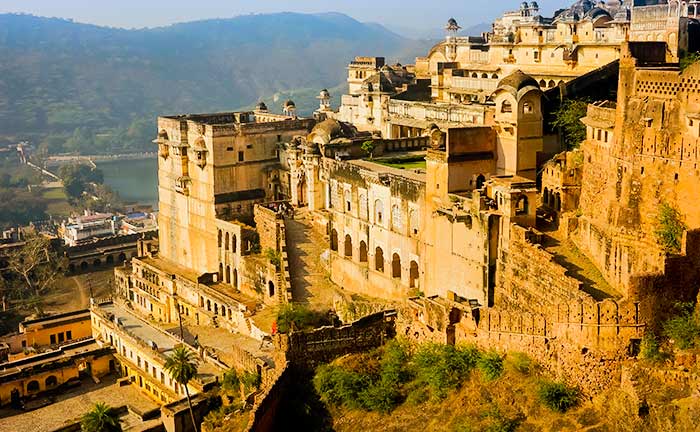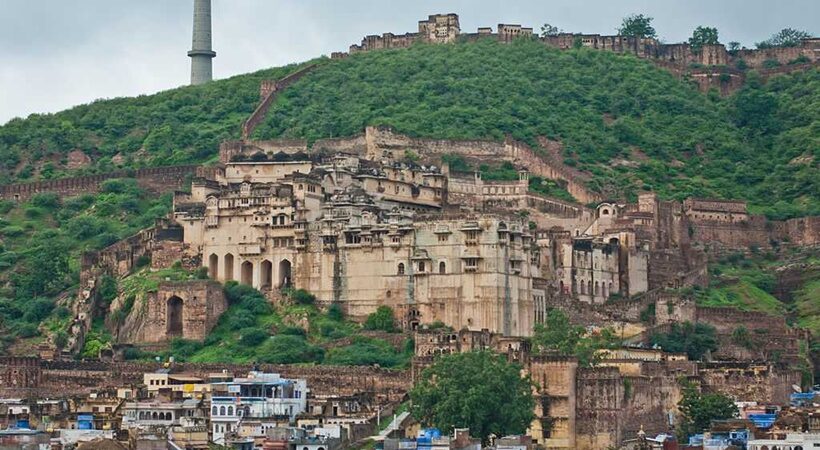Bundi is a small town nestled in a gorge at the base of the Aravalli Hills in Rajasthan. The town is situated around 200 km from Jaipur. Bundi was ruled by the Hada Rajputs for much of its history and is home to some mesmerizing examples of Rajput architecture. Bundi is also known as the City of stepwells, blue city and Chotti Kashi.
Originally, the area around Bundi was inhabited by various local tribes. Later the region was conquered by Rao Deva, a local Rajput chieftain, who took over Bundi from Jaita Meena in 1242, renaming the surrounding area as Haravati or Haroti. For the next two centuries, the Hadas of Bundi were the vassals of the Sisodias of Mewar and ruled by the title of Rao until 1569, when Emperor Akbar conferred the title of Rao Raja upon Rao Surjan Singh after the surrender of Ranthambore Fort and his submission.
The City of Bundi also comprises Taragarh hill. A small habitat developed at the foothills of the enormous fort. The royal palace was constructed on a steep slope overlooking the valley below, providing a view of vast surrounding hinterlands. Garh Mahal became the focus and an imposing landmark on the skyline of Bundi and was visible from the valley below. In the next 200 years, an entire cluster of various structures was built around this area.

Image Credits: travel-rajasthan.com
Bundi’s Taragarh Fort, one of India’s most splendid fortresses, is the crowning glory of Bundi and its landmark as well. It is from here that the Hada Chauhans ruled over the state of Bundi from the 13th century CE. The fort is a majestic sight, but the exterior hides an even more spectacular interior with regal gates, pavilions and hallways. Under the patronage of the ruler of Bundi, the art of mural painting developed a distinct form, now known as the Bundi style. Inside the fort is the Chitrashala created by Rao Ummed Singh. The walls of the Chitrashala are covered in splendid murals, in blue and gold, depicting court scenes and scenes from the legends of Krishna, in Bundi style.

Image Credits: Vervemagazine
The external use of colour on the external façade of houses imparted a unique radiance and vibrancy to the streets of Bundi. Older houses in Bundi have Jharokhas with some screens on upper floors opening onto the street, providing light and ventilation. Apart from enabling movement and connectivity, these streets also performed an important role as facades of the settlement fabric of the walled city.

Image Credits: Wiki Commons
Chaurasi Khambo ki Chhatri is an 84-pillared cenotaph constructed by Rao Raja Anirudh Singh in 1683. The cenotaph was constructed in memory of his wet nurse on the outskirts of the town. It is a stunning structure as it looks particularly dazzling at night when lit up.
Raniji ki Baoli. Source: Wiki Commons
Bundi is known for its stepwells. The most exquisite of them is the Raniji ki Baoli, constructed in 1699 by Rani Nathawati, wife of Rao Raja Anirudh Singh. Considered one of the finest in Rajasthan, the Baoli is 46 metres deep and dazzlingly carved in fluid images, including the avatars of Vishnu.



















